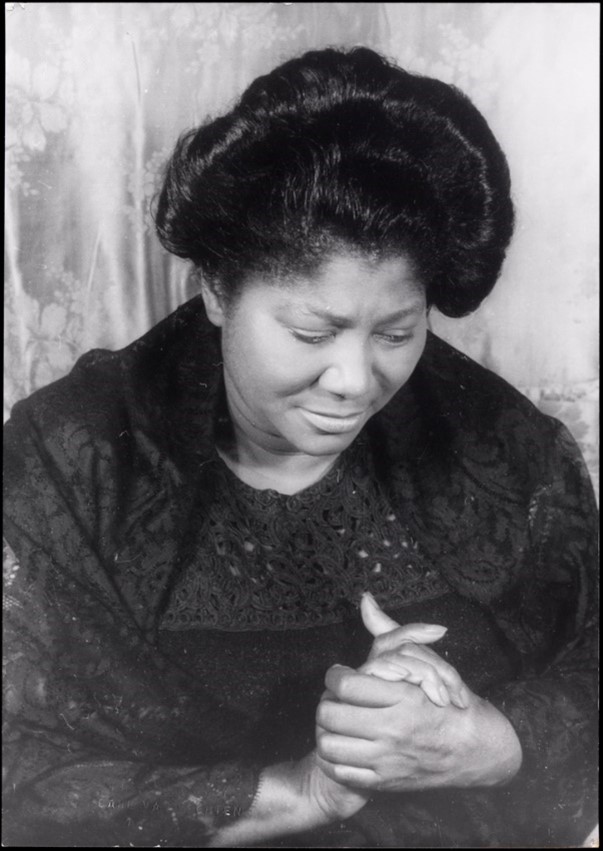
Performers of Gospel Music and Their Techniques: Solo 2
What follows is more information about gospel singers - Mahalia Jackson, Clara Ward, Sister Rosetta Tharpe, Alex Bradford, and James Cleveland - in the golden age. Mahalia Jackson (1911-1972), commonly noted as the "mother" of Gospel, is one of its most celebrated performers. Until the age of seventeen, she lived in New Orleans, where she “...was steeped in and nurtured by the jazz bands and ragtime of her hometown and was deeply influenced by the jubilee shout spirituals of the Baptist and Sanctified churches she attended in her neighborhood” (Jabir 2009, 650). After arriving in Chicago in 1928, Jackson's vocal success can be attributed to her familiarity with the Southern way of life. Indeed, many Blacks that came to Chicago during the Great Migration from the South felt comfortable with Jackson’s singing style and, perhaps more importantly, her unwavering religious conviction as evident in her personable delivery style and presence on stage.
A popular performer in numerous churches, she soon began working with Thomas A. Dorsey and was quickly influenced by his use of blues and jazz harmonies and chord progressions. Dorsey and was quickly influenced by his use of blues and jazz harmonies and chord progressions. Her cooperation with Dorsey and his composition “Precious Lord” helped to catapult her popularity worldwide. She also worked with many other composers and performers, such as Clara Ward. In her recording of Ward’s composition “How I Got Over” (1951), Jackson's use of different vocal techniques set another standard for gospel performers. Though there are numerous recordings of this song with instrumental accompaniment, we have selected her version with voice and piano because it showcases various music characteristics and performance practices. Please review the listening guide in table 17.3.
| “How I Got Over” Mahalia Jackson |
||
|---|---|---|
| A The vocalist begins singing in her natural voice. Notice the different levels of volume. |
“How I Got Over” [00:20-00:45] 00:25 | |
| B The vocalist executes a bending (the pitch is sliding upwards) on the word “soul.” |
“How I Got Over” [00:32-00:34] 00:02 | |
| C The vocalist sings the word “over,” but on the second syllable (“ver”), see sings a melisma. |
“How I Got Over” [00:42-00:43] 00:01 | |
| D The vocalist shouts the phrase “comin’ on over”; executes bending on the word “years,” and again bending on the word “soul” as before |
“How I Got Over” [00:45-1:00] 00:15 | |
| E The vocalist’s volume increases slightly at this point. As you listen, notice the presence of bending, accenting/shouting certain words. Also, listen to the vocalist perform her call-and-response. At 01:00, she sings the call at a louder volume, then responds singing with much less volume. |
“How I Got Over” [01:00-02:04] 01:04 | |
| F The vocalist’s volume increases even more than before. |
“How I Got Over” [02:05-02:16] 00:13 | |
| G As a performance practice, the vocalist’s handclaps accent what she’s saying express the music's deep emotions. |
“How I Got Over” [02:16-02:18] 00:02 | |
| H Again, the vocalist performs her own call-and-response; the call is at a louder volume, then the response singing is in almost a spoken-like manner. |
“How I Got Over” [02:19-02:23] 00:04 | |
| I The vocalist’s volume increases even more than before. |
“How I Got Over” [02:23-02:27] 00:04 | |
| J The vocalist briefly sings the vocable “hmm,” which continues the previous and next section's rhythmical continuity. |
“How I Got Over” [02:58-02:59] 00:01 | |
Precious Lord
Through the storm, through the night
Lead me on to the light
Take my hand precious Lord, lead me home
It's a Highway to Heaven
It's a highway to heaven
None can walk up there
But the pure in heart
It's a highway to heaven
Walking up the king's highway






